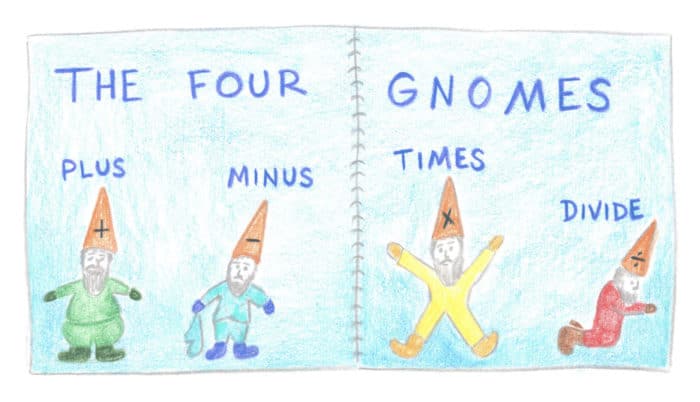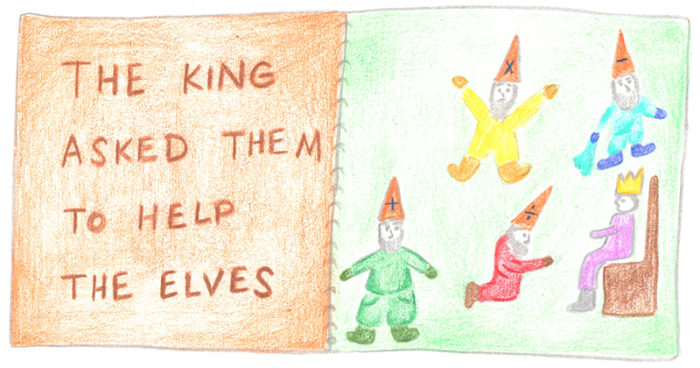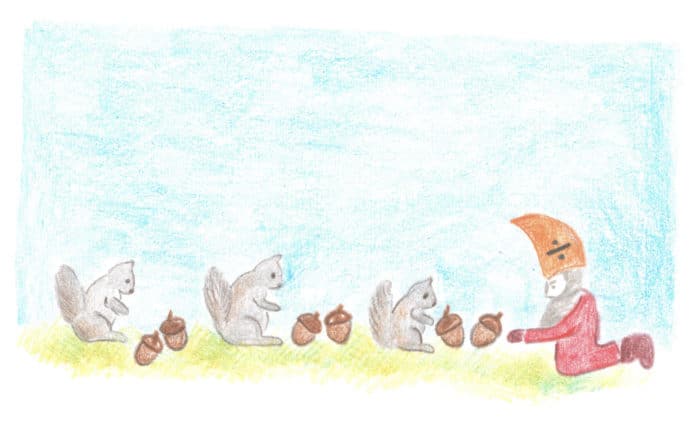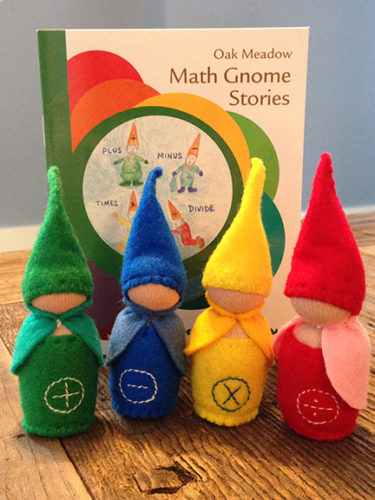Re-imagining Math: Stories to Bring Math Alive
This is a guest post by our sponsor, Oak Meadow
When it comes to math, it seems like there are two types of people: the ones who cringe, and the ones who say, “I love math!” We all want our children to be in the second group, but sometimes the thought of teaching math can unnerve even the most level-headed homeschooler. Luckily, there are lots of ways to give children (and parents!) a very gentle start on the road to math mastery. It just takes a little imagination.
Math explorations in the early grades often introduce the four processes (addition, subtraction, multiplication, and division) playfully, through stories, rhymes, games, and pictures. Engaging the imagination helps children anchor abstract concepts in an experiential way. This helps them remember what they have learned and apply it in novel situations. Math is no good if you can only apply the skill in one way. In order for math to be of practical use, you have to develop flexible thinking.
Math stories are word problems brought to life
Math word problems—a cringe-worthy memory for many adults—are designed to help students apply math skills in practical situations. Math stories are really just expanded word problems, ones that feature engaging characters who need to use math to solve their daily problems.
For instance, in Oak Meadow first grade, students are introduced to four playful gnomes:
Plus, who is always adding more and more items.
Minus, who has holes in his pockets and keeps losing things.
Times, who always finds double and triple the amount that others find.
Divide, who always wants to make sure everyone has equal amounts.
These gnomes can have all sorts of adventures, limited only by your imagination. Kids aren’t too particular about their stories—they seem to like all stories, especially ones told by someone they love.
You can use your own environment to spark new adventures. Maybe you are planting a garden. The gnomes can help you! Maybe Plus is planting a garden, too, and he decides to plant squash for each of the four gnomes. Times can help him figure out how many seeds he’ll need if he wants to plant four mounds of squash with three seeds per mound.
Or maybe you are planning a trip. So are the gnomes! They have to figure out how much food to take (“How many are going? We’ll each want two apples”), or how many hours it will take (“We’ll travel three hours a day for six days”), or how many miles will be left after they have walked halfway. Those clever gnomes can help you figure out anything.
Act out and draw the story to add another layer of understanding
Encourage your child to use tangible items (manipulatives) to help visualize the math questions; some people only think of using manipulatives for very young learners, but students can be encouraged to use them as long as it is helpful. When tangible items are used for groupings, patterns, and counting, numbers become real and relevant. Rather than just memorizing abstract symbols on paper, using pebbles to show math facts can ground numeracy in the child’s physical body, not just the brain. This holistic “knowing” is long lasting and unforgettable.
Maybe you’ve told a story about a gnome who has a bunch of acorns that he wants to give away to his friends, the squirrels. He wants to be fair and make sure each squirrel gets the same amount. Your child can have a pile of nuts while you are telling the story, and try to figure out how to group them so that each pile is equal. Maybe there are 12 nuts and three squirrels. After your child figures out how many nuts for each squirrel, you might say, “Oh! Another hungry squirrel has arrived. We’ll have to divide the nuts again.” Or maybe one squirrel leaves so there are only two. How many nuts does each get now? When children work with numbers in this concrete, imaginative way, it’s an easy transition to translate the pictures and stories into numeric equations.
News flash: Endless worksheets of math problems aren’t necessary! Students only need to do as many problems as it takes to become comfortable and confident. Using stories and tangibles, the number sense is developed in a solid, grounded way. Drawing pictures for the math stories also helps make the abstract more real.
Stories can be used to introduce other math symbols and concepts in addition to number sense. In second grade, the radical division sign is introduced by a story of Barnaby the Squirrel who builds a shed to store his nuts. When hungry animals come asking for food, he draws a picture of his storage shed, with the nuts inside of it and the animals standing outside of it, and then draws on top of the shed the equal share of nuts that each will receive.
Place value and regrouping (carrying and borrowing) are introduced through the kindly Mr. Placevalue, who learns that too many people have tried to move into his Ones House. He solves the overcrowding by moving a group of ten into the Tens House, where people always live in groups of ten.
Everyone is delighted with this solution, and after “carrying” all the bags for the one family of ten moving to the Tens House, everyone gets settled with plenty of room to spare. When the Tens House gets too crowded, ten families of ten are moved next door to the Hundreds House. Tangibles and/or drawings that accompany the story can help students grasp the concept.
Kids can make up stories, too, and then you can “act” them out (with nuts, buttons, seeds, or whatever is at hand) and then draw a picture about them. This picture is then translated into a mathematical equation, one that makes sense on a very practical level.
The great thing about stories is that you can keep adding to them and making up your own adventures. Give it a try and see where your imagination takes you.
Enter to Win!
Oak Meadow is giving one Math Gnomes and their Stories set to an OPC reader! You can use these along with any preschool-first grade curriculum. Just use the widget below to enter to win!
DeeDee Hughes is the Director of Curriculum Development for Oak Meadow Independent Learning, where she loves creating educational experiences that have relevance and meaning for independent learners.








I think cooking is a great way to teach math.
Me too!
Our favorite has been Life of Fred
We love using measuring cups, math blocks, counting beads, Life of Fred, Times Tales, and Teaching Textbooks for math.
I actually discovered Oak Meadow’s program through this site and we are using the Kindergarten curriculum this year. I would love these math gnomes to go with it!
My favorite tool for teaching math is the unit blocks from math u see.
We count everything – from puzzle pieces to how many forks we need.
Missi Klumker:) we are using oak meadow God kindergarten this year and would love these gnomes!!!
The good old blackboard. Thanks for the giveaway.
Marilyn
My favorite Mat teaching tool to date has been Schoolhouse Rocks. My son remembers the songs and I get a flavor of nostalgia because I used them as a child as well. Thank you for hosting this giveaway.
we use beads
This would be so helpful for my now grade 4 student who has problems understanding word problems.
Little White boards kids love doing and checking math practice spelling drawing an more
We love our counting beads, measuring cups and spoons, and Life of Fred books for teaching math.
These look adorable, I love finding ways to make learning fun!
bears michelle miller
I make my own manipulates using felt or using blocks.
Right now my favorite tool for math is UNO cards! So many great games you can play with them. Teaching place value, addition, pairing, etc. plus the kids feel like they’re just playing a game not doing math!!
I find games using base 10 blocks to be helpful in teaching math.
We love the math gnomes! Thanks for this awesome giveaway! I know my girls would love to have a set of these guys!
Funny thing is that an abacus seems to be the best thing to help my special needs child learn math 🙂
My favorite “tool” isn’t really a tool at all. We use math in every-day examples (i.e. how many people are at the table? how many chairs do we have at the table? How many people are in our family versus how many people are home right now). These math gnomes look super cute and fun! It would be a great addition to our schooling.
My favorite math tool so far is the chickens! We do addition and subtraction daily when collecting eggs.
My favorite tool for teaching math is our colored sorting animal set. I didn’t intend for it to be but the kids love to hear the math stories with the animals. 🙂
Manipulative and play! I have been looking at OM Math Gnomes the last few months and winning this would be awesome! My family has been using Oak Meadow for years and we love it! My daughter is going to be doing OM K and I know she would adore this set! Thanks for the chance to win!
Love Oak Meadow!
My favorite tools have been egg cartons and unifix cubes. We have used them for counting, sorting, graphing, colors, addition and subtraction. Love the gnomes.
We loved learning math using gnome stories and math gems! I’m looking forward to teaching math again to my 3 year old.
We use Oak Meadow and we play all kinds new of math games to reinforce the math concepts. We love the gnomes.
frogs on a log 🙂
We have really enjoyed the goofy stories in Life of Fred. One daughter sees numbers in everything, is constantly counting, doing all kinds of problems in her head for fun. She was quickly doing “store math” when she was 4. I feel like I can’t keep up with her, so I’m excited about doing a self paced Teaching Textbooks curriculum this fall. My second daughter lives in our home too and when I asked her if she wanted to learn about math, she screwed up her face and made a disgusted, scared face! Kids are SO different. This would be wonderful for her as she has a rich imagination and an artistic mind.
I’ve found an abacus and cuisine art rods to be great in helping my daughter with math!